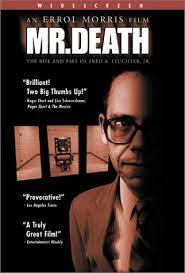Mr. Death, a film by Errol Morris about Fred Leuchter
Among the many accounts I have read of the film Mr. Death, I think that Greg Raven’s is the most instructive (“Flawed Documentary of Execution Expert”, Journal of Historical Review, September-December 1999, p. 62–69). In it, the basic dishonesty of Jewish director Errol Morris is well displayed. It is simply a pity for G. Raven that he does not point out that, in some passages, it is not F. Leuchter who appears on the screen but an actor disguised as Leuchter to have the latter look to play the role of “desecrator” in the ruins of an alleged Nazi gas chamber (a fact revealed and described on the AAARGH website (“Actualités de novembre 2000”, article entitled “Simplet”, French for “simpleton”, the term used by David Irving in his interview by Morris to describe Leuchter).
There is an essential factor that neither G. Raven nor any other revisionist, to my knowledge, seems to have noticed: the absence, in this alleged documentary, of any depiction of an American gas chamber designed for the execution of condemned prisoners. Fred Leuchter is described in words as a sort of technician of death administered in four ways: electrocution, hanging, lethal injection, and gassing. But, if E. Morris, on the one hand, takes care to illustrate the first three manners of execution with numerous images, he well avoids, on the other hand, showing the least image of an American penitentiary gas chamber. And he is right, for the mere representation of the imposing door of such a chamber would, in my opinion, suffice to let the attentive viewer grasp that the putting to death of one man by gassing with HCN calls for extreme safety measures and a highly sophisticated technique.
I have devoted a part of my life to turning over and over again what I call “the argument of the American gas chamber [of the 1930s or ’40s]” so as to demonstrate the absurdity of the alleged Nazi gas chamber. I have often published or shown, as I did at the Zündel trials, photographs of the Baltimore penitentiary’s gas chamber, along with the text of the “Procedure Check List” for executions there (see in Serge Thion’s Vérité historique ou vérité politique?, La Vieille Taupe, Paris 1980, p. 301-309). But I have the impression of not having convinced very many. Neither Fred Leuchter, nor Germar Rudolf, nor Walter Lüftl has taken up my argument. I am therefore happy to note that Errol Morris, for his part, seems, in his own way, to have been receptive to that argument.
December 15, 2000

